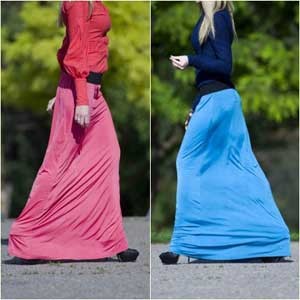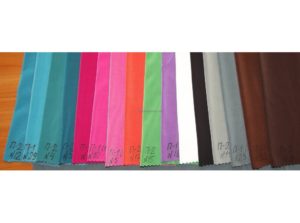A beautiful lightweight fabric for summer suits, dresses, skirts, with decorative elements and an airy texture - this is micro-oil. Flowing material is used in tailoring clothes and beautiful concert items.
Description of microoil fabric
 The fabric was invented not so long ago; rather, it is an innovation. The new product came from Arab countries and is slightly similar in appearance to silk, which is expressed in the same lightness and characteristic shine. The material belongs to knitwear, it is sewn by weaving two or three threads of different qualities and properties.. The result is a composition that has a loose structure, but has sufficient strength.
The fabric was invented not so long ago; rather, it is an innovation. The new product came from Arab countries and is slightly similar in appearance to silk, which is expressed in the same lightness and characteristic shine. The material belongs to knitwear, it is sewn by weaving two or three threads of different qualities and properties.. The result is a composition that has a loose structure, but has sufficient strength.
Compound
In the manufacturing process, only three basic elements are used: polyester, lycra and viscose. To understand, it is worth considering the qualities of each component of the micro-oil:
 Polyester is mainly responsible for the structure, giving strength and durability. It is thanks to him that the fabric does not stretch and does not fade in sunlight.However, the polyester in the micro-oil composition does not allow air flow to circulate normally, which makes the clothes not entirely suitable for wearing on extremely hot days. Of course, the problem can be solved with a loose style, but the sensations from this will change slightly.
Polyester is mainly responsible for the structure, giving strength and durability. It is thanks to him that the fabric does not stretch and does not fade in sunlight.However, the polyester in the micro-oil composition does not allow air flow to circulate normally, which makes the clothes not entirely suitable for wearing on extremely hot days. Of course, the problem can be solved with a loose style, but the sensations from this will change slightly.- Lycra is responsible for elasticity and allows the fabric to stretch. It is quite simple to use, inexpensive and wear-resistant.
- Viscose is a natural material made from cellulose. As part of micro-oil, it is used for a more pleasant and comfortable tactile sensation. Still, natural fabrics have better contact with the skin and allow air to pass through quite well.
Pros and cons of the material
 Like any other, micro-oil has a number of disadvantages and advantages. The advantages include lightness, elasticity, strength. Unpretentiousness deserves special attention - no periodic ironing required, does not fade, no pilling is formed on the fabric. Clothing made from this material lasts a long time and is equally applicable in any season of the year. Such things will dry very quickly, they will not fade or stretch over time.
Like any other, micro-oil has a number of disadvantages and advantages. The advantages include lightness, elasticity, strength. Unpretentiousness deserves special attention - no periodic ironing required, does not fade, no pilling is formed on the fabric. Clothing made from this material lasts a long time and is equally applicable in any season of the year. Such things will dry very quickly, they will not fade or stretch over time.
The disadvantages can be safely attributed to the fact that micro-oil practically does not allow air to pass through. Therefore, wearing clothes made of this fabric in extreme heat is highly not recommended, or you should only stick to loose styles. In some cases, it may cause allergic reactions on the skin. It is quite difficult to choose a style for your figure; it is advisable to consult with specialists or try to carefully consider all possible options.
What do they make from it?
 The bulk of microoil production is focused on supplying material for clothing development.These are mainly dresses, skirts, all kinds of sweaters, capes and light raincoats. In terms of its qualities, this material is very similar to knitwear. It is used both when sewing fitted clothes and loose-fitting outfits.. Various micro-oil sundresses, as well as long dresses, are quite popular. However, based on the above qualities, it is necessary to choose a style according to the season.
The bulk of microoil production is focused on supplying material for clothing development.These are mainly dresses, skirts, all kinds of sweaters, capes and light raincoats. In terms of its qualities, this material is very similar to knitwear. It is used both when sewing fitted clothes and loose-fitting outfits.. Various micro-oil sundresses, as well as long dresses, are quite popular. However, based on the above qualities, it is necessary to choose a style according to the season.
How to care for products made from microoil?
The manufacturer always leaves special recommendations on the back seam on a special label. There is always general information on caring for the item: at what temperature to wash, how to iron, etc. It is worth listing the basic rules that absolutely all manufacturers give:
 Washing at high temperatures has a very detrimental effect on fabric fibers - take this into account and try not to neglect this rule. It is recommended that the water temperature should not exceed 40 degrees Celsius; above this value, the quality of the fabric will begin to deteriorate;
Washing at high temperatures has a very detrimental effect on fabric fibers - take this into account and try not to neglect this rule. It is recommended that the water temperature should not exceed 40 degrees Celsius; above this value, the quality of the fabric will begin to deteriorate;- It is strongly recommended not to use strong chemicals in cleaning - this, again, harms the general condition of the clothes and worsens their appearance;
- When washing, it is recommended to use a liquid detergent. Powder materials negatively affect the condition of the item. We rinse using conditioner, which will help maintain the strength and softness of the material;
- You can dry clothes in any position, the main thing is to ensure access to air. Under no circumstances should you hang fabric on electric dryers and heating radiators - as already mentioned, micro-oil is extremely resistant to exposure to high temperatures;
- When it becomes necessary to iron clothes made from this fabric, they should be turned inside out, and the iron should be set to the lowest possible temperature.
In conclusion, I would like to add that micro-oil is a very interesting material, which is very attractive in terms of price and quality ratio. In its properties and appearance, it is very similar to silk and knitwear, however the price of this fabric is several times lower than the original. If you have doubts whether to buy clothes made from micro-oil or not, then we hope that this article will help you make the right choice.


 Polyester is mainly responsible for the structure, giving strength and durability. It is thanks to him that the fabric does not stretch and does not fade in sunlight.However, the polyester in the micro-oil composition does not allow air flow to circulate normally, which makes the clothes not entirely suitable for wearing on extremely hot days. Of course, the problem can be solved with a loose style, but the sensations from this will change slightly.
Polyester is mainly responsible for the structure, giving strength and durability. It is thanks to him that the fabric does not stretch and does not fade in sunlight.However, the polyester in the micro-oil composition does not allow air flow to circulate normally, which makes the clothes not entirely suitable for wearing on extremely hot days. Of course, the problem can be solved with a loose style, but the sensations from this will change slightly. Washing at high temperatures has a very detrimental effect on fabric fibers - take this into account and try not to neglect this rule. It is recommended that the water temperature should not exceed 40 degrees Celsius; above this value, the quality of the fabric will begin to deteriorate;
Washing at high temperatures has a very detrimental effect on fabric fibers - take this into account and try not to neglect this rule. It is recommended that the water temperature should not exceed 40 degrees Celsius; above this value, the quality of the fabric will begin to deteriorate; 0
0





